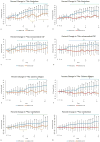Dynamic sodium imaging at ultra-high field reveals progression in a preclinical migraine model
- PMID: 29905652
- PMCID: PMC6150813
- DOI: 10.1097/j.pain.0000000000001307
Dynamic sodium imaging at ultra-high field reveals progression in a preclinical migraine model
Abstract
Under the hypothesis that increased extracellular sodium induces sustained neuronal excitability with the onset and progression of migraine, this study evaluates dynamic in vivo Na fluxes in the brain of a preclinical rodent analogue of migraine. Ultra-high field Na magnetic resonance imaging (MRI) at 21.1 T has demonstrated potential to quantify sodium concentrations with good spatial and temporal resolution after the onset of central sensitization. Sprague-Dawley male rats with implanted intraperitoneal lines were studied by MRI before and after an in situ injection of 10 mg/kg of nitroglycerin (NTG) vs vehicle and saline controls. Slice-selective Na images were acquired using a multislice free induction decay-based chemical shift imaging sequence with resolution of 1.1 × 1.1 × 3 mm for a 9-minute acquisition. A total of 27 repeated scans were acquired over 1 hour of baseline scanning and longitudinally up to 3 hours after injection. Increases of Na MRI signal in the brainstem, extracerebral cerebrospinal fluid, and cisterna magna were evident almost immediately after NTG injection, gaining significance from controls in 36 minutes. The cerebellum and third ventricle also showed sustained trends of increased Na, with the former gaining significance at over 2 hours after NTG injection. The data provide evidence of an early change in sodium concentration, markedly in posterior fossa cerebrospinal fluid and brainstem regions. Further study of fluctuations of sodium concentration and their modulation with treatments could help understand the dynamic features of migraine, locate a putative migraine generator, and guide development of therapeutic measures to correct the disturbance of sodium homeostasis.
Conflict of interest statement
The authors have no conflict of interest to declare.
Figures




Similar articles
-
Metabolic assessment of a migraine model using relaxation-enhanced 1 H spectroscopy at ultrahigh field.Magn Reson Med. 2018 Mar;79(3):1266-1275. doi: 10.1002/mrm.26811. Epub 2017 Sep 17. Magn Reson Med. 2018. PMID: 28921630 Free PMC article.
-
Endogenous Na+, K+-ATPase inhibitors and CSF [Na+] contribute to migraine formation.PLoS One. 2019 Jun 7;14(6):e0218041. doi: 10.1371/journal.pone.0218041. eCollection 2019. PLoS One. 2019. PMID: 31173612 Free PMC article.
-
Sodium MRI in a rat migraine model and a NEURON simulation study support a role for sodium in migraine.Cephalalgia. 2011 Sep;31(12):1254-65. doi: 10.1177/0333102411408360. Epub 2011 Aug 4. Cephalalgia. 2011. PMID: 21816771 Free PMC article.
-
Utility of different outcome measures for the nitroglycerin model of migraine in mice.J Pharmacol Toxicol Methods. 2016 Jan-Feb;77:33-44. doi: 10.1016/j.vascn.2015.09.006. Epub 2015 Oct 9. J Pharmacol Toxicol Methods. 2016. PMID: 26456070
-
Peripheral and central sensitization during migraine.Funct Neurol. 2000;15 Suppl 3:28-35. Funct Neurol. 2000. PMID: 11200798 Review.
Cited by
-
Regulation of CSF and Brain Tissue Sodium Levels by the Blood-CSF and Blood-Brain Barriers During Migraine.Front Comput Neurosci. 2020 Feb 4;14:4. doi: 10.3389/fncom.2020.00004. eCollection 2020. Front Comput Neurosci. 2020. PMID: 32116618 Free PMC article.
-
Cargo Analysis and MRI-Based Therapeutic Assessment of Iron Oxide Labelled Extracellular Vesicles of Hypoxia Human Stem Cells in Ischemic Stroke.J Extracell Biol. 2025 Jul 17;4(7):e70063. doi: 10.1002/jex2.70063. eCollection 2025 Jul. J Extracell Biol. 2025. PMID: 40678584 Free PMC article.
-
Transient enlargement of brain ventricles during relapsing-remitting multiple sclerosis and experimental autoimmune encephalomyelitis.JCI Insight. 2020 Nov 5;5(21):e140040. doi: 10.1172/jci.insight.140040. JCI Insight. 2020. PMID: 33148886 Free PMC article.
-
23Na chemical shift imaging in the living rat brain using a chemical shift agent, Tm[DOTP]5.MAGMA. 2023 Feb;36(1):107-118. doi: 10.1007/s10334-022-01040-4. Epub 2022 Sep 2. MAGMA. 2023. PMID: 36053432 Free PMC article.
-
CGRP Administration Into the Cerebellum Evokes Light Aversion, Tactile Hypersensitivity, and Nociceptive Squint in Mice.Front Pain Res (Lausanne). 2022 Apr 25;3:861598. doi: 10.3389/fpain.2022.861598. eCollection 2022. Front Pain Res (Lausanne). 2022. PMID: 35547239 Free PMC article.
References
-
- Afridi S, Matharu M, Lee L, Kaube H, Friston K, Frackowiak R, Goadsby P. A PET study exploring the laterality of brainstem activation in migraine using glyceryl trinitrate. Brain. 2005;128:932–939. - PubMed
-
- Akerman S, Holland PR, Goadsby PJ. Diencephalic and brainstem mechanisms in migraine. Nat Rev Neurosci. 2011;12:570–584. - PubMed
-
- Ashina M, Hansen JM, Olesen J. Pearls and pitfalls in human pharmacological models of migraine: 30 years’ experience. Cephalalgia. 2013;33:540–553. - PubMed
MeSH terms
Substances
Grants and funding
LinkOut - more resources
Full Text Sources
Other Literature Sources
Medical

